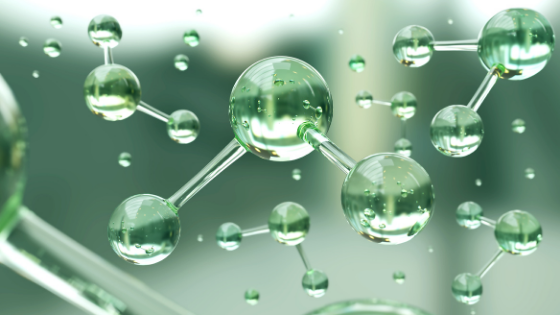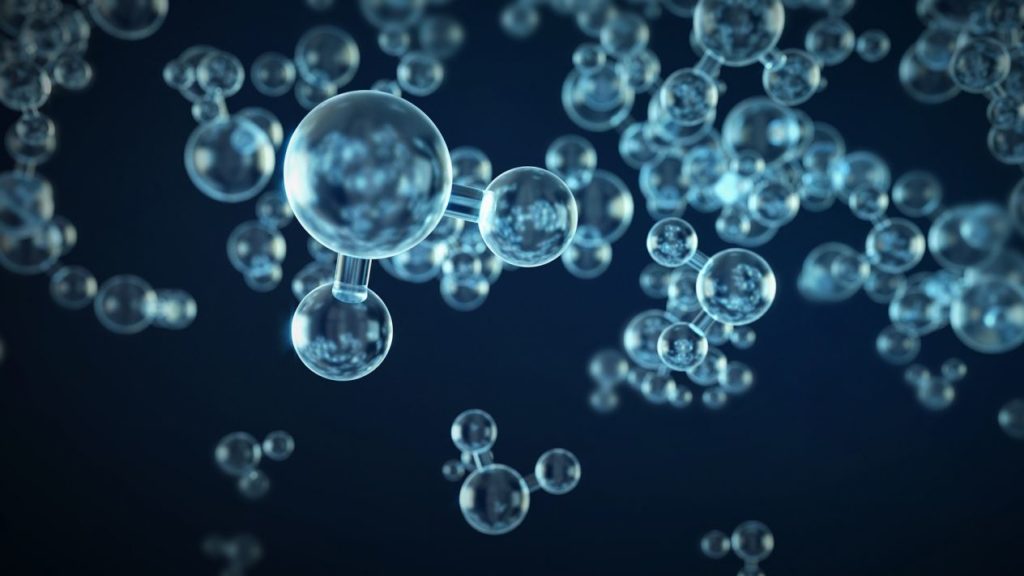Schmidt is looking to achieve what many before him have tried and failed to do. He’s looking to create a system that produces hydrogen for self-consumption and for use as seasonal storage. The targeted costs are promising, provided there is cheap green electricity to power the electrolyzers.
Schmidt is not the only one to pursue this revolution. Several small and large companies are in the starting blocks. Central versus distributed is not only an issue in power generation. There is also lively debate about which approach is more promising for the production of green hydrogen.
Savings potential
Generating hydrogen is simple in principle. Electrolysis has been around since 1800. The method known as alkaline electrolysis has been in commercial use since the middle of the 20th century. It uses a cell with a cathode, an anode and an electrolyte based on a solution of caustic salts. When voltage is applied, water decomposes in the alkaline solution. Hydrogen is formed at the cathode and oxygen at the anode. Between the two electrodes is a membrane that only allows negatively charged ions of oxygen and hydrogen (OH-) to pass through, thus separating the gases. Heat is generated during the reaction which, when harnessed, increases its efficiency. The hydrogen obtained must then be cleaned, dried and if necessary, compressed.
The electrolyte is liquid, which means that the alkaline electrolyzer requires more peripheral equipment, such as pumps for the electrolyte, solution washing, and preparation. Although it is currently the cheapest of all electrolysis processes to purchase, it has relatively high maintenance costs.
The much more recent electrolysis method, which uses a proton exchange membrane (PEM), is different. It reverses the fuel cell principle and requires no liquid electrolyte. Water is pressed through a stack of two electrodes and a polymer membrane. It only allows positively charged hydrogen protons to pass through. Platinum is usually used as a catalyst in the cell. The thin cells consisting of a membrane and a pair of electrodes can be arranged in stacks to achieve better performance. Compared to alkaline electrolysis, PEM electrolysis has the advantage of quickly reacting to the fluctuations typical of renewable power generation. This technology is often used for distributed systems because the equipment is low-maintenance and delivers high-quality gas.
A newer variant is the anion exchange membrane (AEM) electrolysis employed by Enapter. Like alkaline electrolysis, this method allows negatively charged ions (OH-) to pass through the membrane. AEM avoids the use of the costly precious metals required as catalysts in PEM electrolysis. The process is also effective at smaller-scale, making it suitable for decentralized applications.
High-temperature electrolysis uses a somewhat different concept. Ceramic membranes that conduct ions at very high temperatures separate superheated steam at 600 to 800 degrees Celsius into oxygen and hydrogen. Since most of the energy required for this process is already provided by heat, the electrical energy requirement is lower. When industrial waste heat is used, which costs little or nothing, this method can be very efficient. Measured in terms of the electrical input, its efficiency is higher than with other methods.
Price strategy
Ultimately, however, efficiency is only indirectly important; what matters most is the cost. The overall cost comprises the cost of the electrolyzer, including maintenance and replacement of worn-out membranes, the price of the electricity used for the process, and any subsequent costs for drying, cleaning and compression of the gas, as well as transport.
A 2018 study by Fraunhofer ISE and IPA estimated the investment costs for a PEM electrolyzer that produces one standard cubic meter of hydrogen in one hour at around $7,600. In the meantime, however, prices have fallen to between $4,900 and $6,000, says Tom Smolinka, head of the department for chemical energy storage at Fraunhofer ISE and one of the authors of the study. The alkaline electrolyzers, which at the time of the study cost $3,300 and $6,000, are now said to be considerably cheaper in China. At the time the study was conducted, there were essentially no market-ready applications for high-temperature electrolysis.
Smolinka estimates that the production of a membrane-electrode unit – the heart of a PEM electrolysis cell – accounts for 60% to 70% of the total cost, while pure material costs – including the expensive precious metals – account for only 30% to 40%. Furthermore, he adds that the power electronics used in large electrolyzers are currently not yet a mass product, but rather a customer-specific one-off item. Accordingly, prices are likely to fall dramatically once sales volumes increase. Up to now, most electrolyzers have been manufactured in work processes involving little automation or even entirely by hand, says Smolinka. “Highly automated production, especially for cell components, as already exists for PEM fuel cells, would not be a problem technically.” However, he adds, that the current low level of market demand is preventing manufacturers from making the necessary investments.
Investment costs
A number of market players are working to bring down investment costs. An example of this is the joint venture between ITM Power and Linde, which plans to open a semi-automated factory in Sheffield, U.K., this year to produce 1 GW of electrolysis capacity per year, primarily for multi-megawatt projects, such as the one in Cologne. Other well-known companies have also announced major projects and are expanding production. NEL, for instance, is currently gearing up for a 20 MW project in Denmark, and Hydrogenics is readying the launch of a smiliar-sized project in Canada. Alongside project size, stack performance is also improving. Currently, stacks are generally available with an electrical input power of 400 kW. Soon, several of the players want to increase this capacity to 1 MW. Scaling the size should reduce costs.
Enapter takes a different approach. The Italian-German company is resolute in its commitment to a small standardized product that can be produced in ever larger quantities and then installed side-by-side as needed. Founder and CEO Schmidt draws parallels to the computer world to illustrate the plausibility of the concept. Distributed personal computers have replaced mainframe computers to a large extent, because high production volumes made them cheaper to make than a small number of mainframe computers. Similarly, the Enapter product is expected to reduce costs compared to the large central electrolyzers, which are not manufactured industrially.
This discussion about whether the goal is achieved faster by scaling up to larger units in smaller quantities or by scaling up to larger quantities of smaller units is common in many industries. Skeptics say that the latter approach is not as promising for electrolyzers for reasons of physics. Unlike computers, the performance of electrolyzers would not increase many times over as they were scaled down in size. On the other hand, with AEM electrolysis, the possible elimination of precious metals could make distributed generation viable for the mass market.
At a current price of $9,800, the device supplies half a cubic meter of hydrogen per hour, or one kilogram of hydrogen every 24 hours. With a targeted service life of 30,000 hours, the unit currently achieves a price of $7.30/kg, which corresponds to $0.19/kWh (calorific value). These figures, however, do not include the price of the 54 kWh of electricity required to produce 1 kilogram of hydrogen with AEM electrolysis. If we assume, for example, that the input electricity costs $0.055/kWh, this adds another $3/kg, or $0.075/kWh of hydrogen, to the production cost.
As soon as automated production at the Pisa site starts up as planned in four years time, the electrolyzer will be so cheap that the target of $1.64 per kilogram minus electricity costs will be achieved, says Schmidt. At that point, the developers hope that it would not only be worthwhile to use the device for distributed generation, but also to assemble larger aggregates, as in the computer example. Installing 416 of the units would achieve an output of 1 MW.
Source of uncertainty
The service-life of the devices is included in all of the cost estimates, which, as with any new technology, cannot be easily proven. For example, it is impossible to verify whether an AEM electrolyzer will really last 30,000 hours and a PEM electrolyzer between 60,000 and 80,000 hours, as the manufacturers claim. However, Schmidt from Enapter and Tom Smolinka’s researchers agree that AEM and PEM cells scarcely age at all over time. Also, whether the electrolyzer runs under full load or only at half power makes little difference.
Ultimately, the membrane itself is not the only factor that determines service life. “The greatest influence on the service life is the water quality,” says Smolinka. Impurities accumulate in the fine pores of the membrane, which block them, or in the case of salts, form bridges.
Another factor that gums up electrolysis cells is the temperature. Excessive loads lead to higher temperatures in the entire system, and unevenly coated electrodes can create hot spots.
Areva H2Gen will address this challenge over the next three years. In a research project at Industriepark Höchst, the company is using a 1 MW PEM electrolyzer. In addition to hydrogen production, it will also provide primary control power in the future, which means that it will sometimes be operated at twice its capacity, while at other times at only a fraction of its 250 kW capacity. If the concept proves practicable, it will not only open up additional income for operators of electrolysis plants but could also help to stabilize the electrical grid.
According to cost calculations by project manager Lucas Busemeyer, Enapter’s cost objective can already be achieved today with Areva H2Gen’s centralized unit. With continuous utilization of the plant – 8,000 operating hours per year over a period of 20 years – a hydrogen price of $3.90/kg is achievable at an electricity price of $0.055/kWh. This estimate assumes that the PEM stack would be replaced once after 10 years.
Significant reductions
Since power costs are a decisive factor in total generation costs, the technology and its utilization cannot be separated. Anyone purchasing green electricity from the grid, whether through PPAs or as certified green electricity, has to consider connection fees, levies and surcharges on the electricity price, whatever the legal regulations may be. However, the electrolyzer can connect directly to an existing gas or hydrogen network, as is the case with Shell and Areva H2Gen, in Höchst.
Operators who generate hydrogen with smaller solar systems may be able to make use of the heat and thus increase economic efficiency, and may also use the fuel directly for heating or for refueling vehicles without the need to transport it. Such producers also save a portion of the levies and surcharges on the electricity price and reduce the burden on the grid.
In principle, however, investors who plan to use solar energy alone to operate the electrolyzer will have to accept a longer payback period, as the energy is only available for a low number of full-load hours.
Significant reductions in electricity consumption for electrolysis can be achieved with high-temperature devices that have the highest electrical efficiencies of 80% to 90%. One of the pioneers for this technology is Sunfire from Dresden. Instead of 55 kWh as in PEM electrolysis, only 41.4 kWh of electricity are needed to produce 1 kilogram of hydrogen. To do this, however, the electrolysis cell must be heated. It is therefore a good idea to install them where industrial waste heat is generated, such as in steel plants. If steel production is to be CO2-free, sector coupling is perfect, because the hydrogen produced can be consumed immediately. With the oxygen membrane Sunfire uses, not only can water be split to produce hydrogen, but any molecule containing oxygen, such as hydrocarbons or even carbon dioxide, can be separated, says Nils Aldag, COO of Sunfire. The resulting gas can easily be processed into synthetic crude oil, which is much easier to transport than bulky hydrogen.
The question of centralized or distributed electrolysis will probably not be an either/or but a both/and matter in the end. The task is enormous. The Shell Rheinland refinery in Cologne alone, which according to the company is the largest refinery in Germany, requires 180,000 metric tons of hydrogen a year. It is still produced mainly by steam reformation from natural gas, which produces a lot of climate-damaging CO2. Since mid-2019, the company has been building a 10 MW electrolysis plant at the Wesseling plant. According to Shell, the world’s largest plant utilizing proton exchange membrane technology in the world will be installed there. And yet around 140 such plants would be necessary for just this one company to switch to green hydrogen.
Schedule a call with us to see what green hydrogen would look like for you:

This article originally appeared on pv-magazine-usa.com, and has been republished with permission by pv magazine (www.pv-magazine.com and www.pv-magazine-usa.com)









 Image: Horizon Power
Image: Horizon Power

 Image: Shell Rheinland
Image: Shell Rheinland

